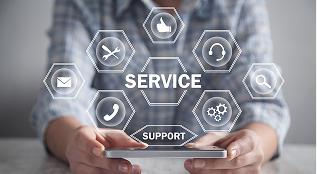1. What makes customer service crucial for online businesses?
Retaining customers is more straightforward than acquiring new ones, so exceptional customer service can significantly contribute to your business growth by fostering loyalty among your customers and promoting repeat purchases.
Research indicates that more than 90% of consumers are inclined to make repeat purchases from a business following a positive customer service experience. Additionally, studies show that enhancing customer retention by merely 5% can lead to a profit increase of over 25%.
On the other hand, poor customer support experiences can significantly harm your ability to retain customers, driving away valuable repeat business. Additionally, they can adversely affect your ability to attract new customers by leading to negative online reviews, which can severely undermine e-commerce ventures.
It is essential to allocate the right amount of time and budget to cater to your customers effectively, and to choose the most suitable channels for this purpose.
2. What does customer service mean?
Customer service is the way you assist customers in making purchases from your online store and utilising your products or services effectively.
This encompasses:
Enabling sales. Helping your customers navigate the entire journey of buying, receiving, and returning your products or services.
Responding to enquiries. Assisting your customers with any particular questions they may have about your product or service.
Ensuring excellent after-sales support. This guarantees that your clients can effectively utilise your product or service as soon as they get it.
Addressing challenges. Effectively addressing issues and complaints promptly and efficiently, such as concerns regarding damaged or missing items, delays in delivery, or dissatisfaction with products or services.
There are three primary approaches to delivering that support:
Self-service assistance. Empowering customers with resources to independently seek answers to their queries.
Active assistance. Automatically delivering information at key moments to anticipate customer needs, potentially activated at a particular stage in the order process or in response to a customer's action.
Personalised support. Making sure customers have the opportunity to connect directly with a staff member whenever they wish or require assistance.
Every business has a role for each of these elements.
3. Self-service assistance
Many individuals are content, or even inclined, to seek out information or address a problem on their own initially. For some, if they are unable to achieve this, they will switch to a competitor where they can find what they need.
Begin by outlining all the essential information that customers must have regarding your business and products to facilitate their purchasing decision. Consider what details they require after receiving the product and how you can guide them to seek assistance in case of any issues.
To kick things off, begin by examining the kinds of questions that customers typically ask. Next, determine how you will organise, develop, and showcase that information.
Keep in mind that various kinds of information might be most effectively presented in distinct formats. For instance, technical information might be most effectively provided in a downloadable format, while instructional content could be more engaging when presented in video form. Think about whether it would be beneficial to present your content in various formats.
Content for your website
Your clients will anticipate that all crucial information is available on your website and that it is easily navigable.
Your web analytics might reveal a division between users who prefer traditional navigation methods to locate information and those who directly utilise the search box on your website. It is essential to address both aspects, ensuring that there is a coherent structure in the presentation of information and the connections between them.
The various forms of assistance content you should consider offering may encompass:
Standard information for businesses. Many customers will seek essential information such as product dimensions, delivery options, and lead times. Therefore, it is beneficial to include this information on your website. Establish a consistent method for cataloguing all your products to guarantee that you always include essential details.
Commonly asked questions. Sharing information in a FAQ format can enhance engagement and provide reassurance to customers that they are not alone in their enquiries.
Guidelines and step-by-step tutorials. Share links to assembly instructions or maintenance guides for your product right from the product page. For more intricate offerings such as software, it might be beneficial to establish a knowledge base. When you stop offering products, make sure there is a section on your website where customers can easily access that information.
Get in touch with us. It is essential to provide easily accessible contact details for customers who wish to reach out directly when needed.
Conversational Agent
Rapidly expanding businesses often struggle to maintain sufficient staff to handle incoming customer enquiries, particularly when customers require support around the clock. If numerous queries are common, then a chatbot can effectively guide users to essential information.
Chatbots are software applications that enable companies to engage with their customers online through a chat interface or messaging service, providing a “humanlike” or conversational experience. Numerous customers find it convenient to utilise these features on a business's own website or app, as well as through third-party platforms like Facebook Messenger, Instagram, and WhatsApp.
There are various levels of sophistication when it comes to developing chatbots, including:
automated replies on Facebook Messenger
a ready-to-use software that allows you to automate your own questions and answers using a rule-based chatbot
AI chatbots leverage machine learning to grasp the context of enquiries, enabling them to provide relevant responses and even formulate their own answers in a more conversational manner.
The advanced bots can be quite costly for smaller enterprises, particularly since they cannot completely substitute for human interaction in providing effective customer service. Even small ecommerce ventures can gain from implementing fundamental rule-based chatbots.
To determine if it's worthwhile to explore for your business, you should assess the potential for enhanced customer service standards and cost efficiencies.
Examine all the incoming enquiries you are currently receiving from your direct response channels.
Determine the number of standard queries that have consistent answers, in contrast to those requiring personalised information from an individual.
Evaluate the duration it takes for customers to get an initial response and for their enquiries to be resolved.
Keep track of the time required to address standard queries and, consequently, the annual cost in staff time.
You can evaluate if the investment in establishing and utilising a service from an eCommerce chatbot provider is beneficial.
Before making a decision, it's important to keep in mind:
To address common queries effectively, consider enhancing your website content to provide clearer answers or explore alternative formats like video presentations.
It’s impossible to completely remove all standard queries, as there are times when individuals prefer to connect with an actual member of your team.
It is essential to configure the system to direct customers to a human representative if they find themselves repeating questions or receiving the same responses multiple times.
4. Active assistance
This approach allows you to deliver essential information to customers exactly when they need it, utilising technology or an automated system that seamlessly connects them with a customer service representative at the most opportune moment.
Automated email and SMS services
Automated emails and SMS (text messages) serve as an essential customer support resource, widely utilised by e-commerce enterprises to assist customers during their purchasing journey. These updates keep customers aware of their purchase status, which can help minimise incoming enquiries regarding delivery. Additionally, these communications are frequently sent through your ecommerce platform.
These automated messages can assist you:
Ensure your customers are always informed. Customers typically anticipate receiving auto-generated notifications for order confirmations and invoices, dispatch notes and delivery details, labels, or guidance for returns as standard transactional emails.
Address frequently asked queries. Addressing potential enquiries regarding delivery and return processes in an email can be beneficial.
Assist customers post-purchase. A timely email during the delivery period can assist customers in maximising their purchase and simplify the process of using and assembling it, as any details provided at the time of order may have been overlooked or forgotten by now. This could involve sending automated emails containing information like installation guides or technical documentation for software downloads, assembly instructions for furniture, and details on how to access ongoing support, such as personalised sessions with course purchases.
Please provide the contact details. Typically, automated emails are labelled as “no-reply” since they are not designed for engaging in conversation. Ensure that every email you send includes clear instructions on how customers can directly reach you, making it easier for them without the need to navigate your website for that information.
This article discusses the key factors to consider when selecting an email marketing platform for sending automated transactional emails and text messages, aimed at enhancing customer service excellence.
Proactive outbound calls
Certain ecommerce ventures provide a uniquely intricate range of offerings, including premium or customised items, as well as products that demand significant delivery efforts. For these enterprises, reaching out to customers after they have placed an order or just before a scheduled delivery can serve as a timely intervention to avert problems that may later demand extensive customer service efforts or expensive returns.
For instance, a company dealing in household appliances reaches out to customers to confirm that their online order is precisely what they meant to order, to go over delivery specifics, and to understand the customer’s needs and circumstances. This allows them to gather information that is often difficult to obtain through online forms or may be overlooked (for instance, if the customer requires assistance with appliance installation, they verify whether the customer remembered to ask for that help). The customer service representative will also record any unusual situations that may impede delivery drivers, potentially leading to subsequent delays in other deliveries.
When you think about the expenses associated with returns for incorrect orders or the time required for a complicated installation, it becomes evident how beneficial a proactive phone call can be.
Outbound calls can serve as an effective method to proactively follow up on sales and collect valuable feedback. However, it is essential to approach this with care to ensure that customers do not view it as an unwelcome interruption.
5. Personalised assistance
It is crucial to offer one or more direct response channels for your customers to reach out to you directly. Building a relationship and establishing trust is crucial for customers, especially in the context of digital enterprises.
Since this is the most resource-intensive support option for your business, there are several factors to consider before deciding on the best channels to implement this.
Begin by determining the channels that your customers are most inclined to utilise. For instance, senior audiences typically prefer the option to communicate over the phone, while younger individuals may find it more convenient to interact through digital platforms.
Evaluate this by identifying the channels your business can genuinely dedicate itself to. It’s unproductive to provide multiple communication options if you’re unable to handle them effectively. If you run a small shop or are just beginning your journey, focus on the channels you can effectively handle. Invest time in perfecting these before thinking about expanding or enhancing them as your business develops or as new opportunities come up. It is far more effective to provide excellent service on a limited number of channels than to overextend and deliver subpar service across many.
Establish practical expectations regarding response times. Customers seek swift resolutions, making response time crucial, but it's important to avoid overpromising. It's more effective to be truthful instead of promising a response within one hour if you are unable to deliver on that commitment.
Collect feedback. Direct response channels serve as an excellent means to gather feedback. If a majority of the complaints are centred around a specific aspect of your business, it becomes clear where to direct additional attention and resources. If you find yourself receiving repetitive queries, consider enhancing your website with additional information. When individuals express interest in particular items, think about the potential for introducing a new product or service.
Monitor the effectiveness of your responses. No matter what systems you have in place, it's essential to monitor the time it takes for you to deliver your initial response, whether it's answering a phone call, engaging in a chat, or replying to an email. Observe the volume of enquiries received and assess the duration required to address issues. Take this into account along with the overall customer satisfaction levels for your business by utilising feedback surveys or tracking your Net Promoter Score.
Incoming phone calls
Numerous enterprises will implement self-service and automated information systems to minimise the resources required for handling unnecessary inbound calls.
However, there are times when customers prefer to engage with another individual. From a business standpoint, this can be beneficial, as one-on-one interactions with customers often yield valuable insights and feedback.
No matter if you run a small store or a larger enterprise, having effective processes and systems is essential to ensure a positive experience for both your customers and your team. For instance, it is essential to log queries and issues accurately to facilitate their resolution, and you should have quick access to your customers’ orders to assist them effectively during the call.
To maximise the benefits of this channel, keep in mind:
Extended wait times can worsen problems, but this can be reduced if a caller is informed about their position in the call queue and/or has the option to request a callback instead of waiting.
Training staff and ensuring they have strong product knowledge is crucial. Customers dislike being passed around, having to recount their issues to multiple people who lack the necessary expertise to assist them.
Social media platforms
In recent years, the rise of brands on social media has transformed these platforms into a primary channel for customer service, where customers seek answers to their questions and solutions to their problems. Customers often feel that they will receive a faster response through social media, owing to its open and public format. In fact, numerous large enterprises maintain specific social media accounts solely for customer support, frequently utilising platforms like Twitter.
This indicates that if your business maintains a presence on platforms like Facebook, Instagram, Twitter, LinkedIn, and others, it is likely that your customers will reach out to you through these channels. The kinds of assistance you can expect to provide on social media encompass:
Responses to enquiries – where you can offer concise answers to particular questions and direct users to additional information on your website.
Addressing concerns – numerous individuals reach out on social media platforms when they encounter a problem or complaint that needs attention. Delivering quick, professional, and supportive replies is essential.
It is essential to incorporate your social platforms into your customer service strategy. Ensure that you:
Enable notifications and consistently monitor your social media channels for any customer interactions.
Reply quickly and courteously, keeping in mind that this is a public platform and your responses will be visible to prospective clients.
It is important to refrain from sharing personal information or requesting such data in public forums. For specific enquiries, consider moving the discussion to a private setting.
Address negative feedback and complaints in a fair, timely, and professional manner, avoiding defensiveness. Create a policy to address social complaints effectively, ensuring that issues are resolved to the greatest extent possible, thereby fostering trust among future customers in your commitment to delivering quality service. When faced with excessively negative remarks, aim to move the discussion to a private setting where it can be addressed more effectively.
Develop a template for addressing frequently asked questions.
Establish social media guidelines for all team members engaging online, ensuring that interactions remain professional and aligned with the brand's identity.
For insights on effectively handling social customer services, check out our guide on engaging with customers online.
Real-time chat
A growing number of individuals, particularly among the youth, now consider live chat to be a viable substitute for phone calls.
Your customers will find it easy to use, allowing for real-time online chats to occur in a chat box on your website. Your clients just enter a brief query in the box and hit send. Subsequently, your agent responds. Unlike a chatbot, your visitors engage directly with a human customer service representative.
This software allows you to integrate a chat window on any web page, enabling customers to seek assistance instantly when they can't find the information they need. This quick access to support can reduce the likelihood of them turning to a competitor's site instead of waiting for a phone call or email response. Your customers can access it without needing to install anything on their devices.
Automate the chat window with a pre-filled message that pops up at moments when customers might require assistance, such as when they have been taking a while to select a product or decide on delivery options.
From a business standpoint, live chat allows a customer service representative to engage with multiple customers simultaneously (which isn't feasible with phone calls), and they can utilise prepared responses for common enquiries to enhance response efficiency.
There is potential for greater refinement in the area of personalisation. It is advisable to ask for a customer's name and email address at the beginning of the interaction. This allows the customer service representative to access previous order history or use the information to provide further assistance after a live chat. Encourage sign-ups for newsletters and seamlessly integrate this data with your CRM system.
However, as is often the case with data-driven choices, it's essential to remember the fundamentals.
Customers anticipate a rapid response when using live chat, and failing to meet this expectation can lead to their frustration.
Additionally, certain customers may feel uncomfortable sharing excessive personal information and could perceive efforts to be overly personal as intrusive. It’s all about finding the right equilibrium.
Research consistently indicates that approximately 25% of users prefer email as their communication choice. This approach is pertinent for both small and large ecommerce enterprises, offering a budget-friendly and efficient method to cater to your customers' needs.
Email serves as a reliable and efficient medium for addressing customer enquiries, ranging from sales facilitation to after-sales support and problem resolution.
Using email offers two key advantages:
Simplicity in technology. For small enterprises and startups, leveraging this tool can often be more straightforward than other digital channels, as it is something nearly everyone knows how to use. As a business, you will find that the entry requirements are minimal; all you need to kickstart this channel is an inbox.
More depth and less urgency. Email provides you or your team with additional time to respond, as it is not an 'immediate response' channel like phone calls or live chat. Providing detailed information through email is often more convenient than using brief text messages or chat.
Tools for managing customer service
Larger businesses might find it beneficial to adopt advanced tools for efficiently managing and addressing a higher volume of incoming email queries, along with live chat and social media interactions.
Different systems offer a range of features and benefits, but you might find the following capabilities available:
Handle a queue of requests, prioritise effectively, and monitor responses closely.
Facilitate collaboration among multiple customer service agents when information must be collected from the team for a unified response.
Avoid overlapping efforts by ensuring that individuals do not inadvertently reply to the same person simultaneously.
During busy periods, guide customers from live chat to email.
Tagging options to effectively categorise enquiries, enabling the activation of specific workflows and enhancing reporting capabilities.
Customer data can be accessed so that agents can comprehend the history of any prior interactions, regardless of whether they were positive or negative.
Get assistance from DigitalBoost to achieve all your goals!
For additional guidance and assistance on every facet of your digital marketing, processes, and platforms, explore our DigitalBoost programme. Providing complimentary one-on-one consultancy, online resources, training sessions, and webinars to assist businesses in India in enhancing their digital capabilities.






